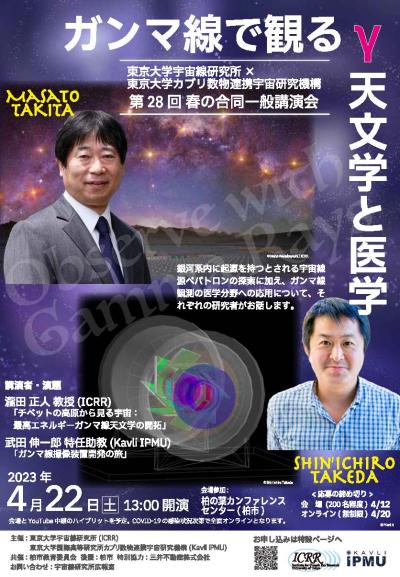March 2, 2023
Kavli Institute for the Physics and Mathematics of the Universe (Kavli IPMU)

This April 22 (Sat), the Kavli IPMU and Institute for Cosmic Ray Research (ICRR) will be co-hosting a hybrid Joint Public Lecture "How Gamma Rays are Seen in Astronomy and Medicine".
This event is recommended for participants with junior high school level science knowledge. Admission is free. Online participation has no seating limits, but pre-registration is required.
For more details, visit the Institute for Cosmic Ray Research website.
Event Summary
Time & Date: 1PM - 4PM, April 22 (Sat) 2023
Venue: Kashiwanoha Conference Center (Kashiwa city) or online
Host: Kavli Institute for the Physics and Mathematics of the Universe (Kavli IPMU), Institute for Cosmic Ray Research (ICRR)
Supported by: Kashiwa City Board of Education, Mitsui Fudosan Co., Ltd. (special support)
Support: Kashiwa City
Difficulty level: Junior high school level
Admission: Free
Seating:
- Onsite venue 260 seats (if registration numbers exceed seat numbers, a lottery will be drawn to select participants. A satellite venue will also be set up with 80 seats)
- No limit for online participants
How to register: Institute for Cosmic Ray Research website
- Deadline for onsite participation: April 12 (Wed)
- Deadline for online participation: April 20 (Thu)
How to attend: Details about how to attend will be sent to those who have completed registration via email
Contact us:
About the event: 04-7136-5981 / Email: koukai-kouza_at_ipmu.jp (Kavli IPMU Public Relations)
About registration: 04-7136-5148 / Email: icrr-pr_at_icrr.u-tokyo.ac.jp (ICRR Public Relations)
* Note: please change _at_ to @
Program
1PM - 1:50PM
Lecture 1:
The Universe from the Tibetan Plateau: Pioneering High Energy Gamma Ray Astronomy
Speaker: Masato Takita (ICRR Professor and Deputy Director)
In collaboration with China, we installed a cosmic ray and cosmic gamma ray observatory on the Tibetan Plateau, 4300m above sea level, to carry out research on the origin, acceleration, and propagation mechanisms of high-energy cosmic rays. Cosmic rays that fall on earth from space (mostly protons, the nuclei of hydrogen atoms) were discovered in 1912. Cosmic rays on the earth's surface (mostly muons) are invisible to our eyes, but about every second, one passes through space the size of the palm of your hand. However, the origin of cosmic rays is still shrouded in mystery, despite the fact that more than 100 years have passed since its discovery. Recently, new discoveries on the origin of high-energy cosmic rays have been obtained by the observation equipment installed in Tibet. In this lecture, I will talk about these findings.
1:50PM - 2:40PM
Lecture 2:
The Journey to Developing a Gamma Ray Imager
Speaker: Shin'ichiro Takeda (Kavli IPMU Project Assistant Professor)
Hard X-rays and gamma rays, which have energies hundreds-of-thousands to a million times higher than visible light, are everywhere in nature. They are emitted from the vicinity of black holes and from inside atomic nuclei. My research motto is to develop imaging techniques for hard X-rays and gamma rays, and make measurements of unknown phenomena in the universe and life possible. Although it may be too early to look back, we have already created a large variety of instruments ourselves, starting with a gamma-ray telescope for astronomical observation, followed by a device for visualizing radioactive cesium scattered by the Fukushima nuclear power plant accident, a device for imaging cancer stem cells inside tumors, and a device for visualizing therapeutic agents in alpha-ray cancer therapy. The journey of developing hard X-ray and gamma-ray imaging systems has been a journey of encountering new surprises. I look forward to sharing my story with the audience.
3PM - 4PM






